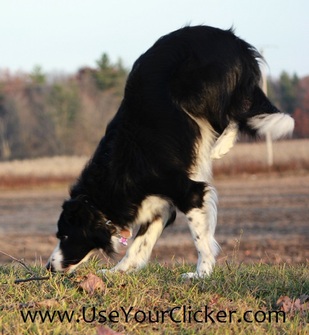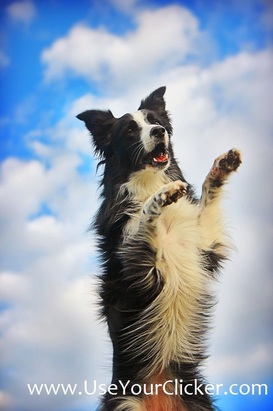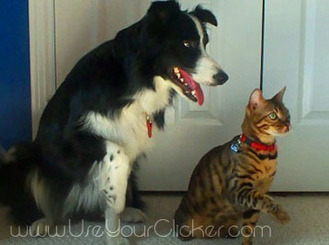"Training is something you do with your dog, not to your dog."
What is a Clicker?"A small, plastic hand-held device that makes a clicking noise when its metal tongue is pressed down and released."
This may be similar to how your dictionary defines this training tool. Clickers, however, are much more than a plastic noisemaker. With their aid, they provide the most humane, fun, and successful results from animal training. |
Definitions:Marker — A sound or visual signal used to communicate to an animal that the behaviour they were executing at the exact moment the sound or visual signal was given was correct, and that a reward is to follow. (Examples: clicker, finger snap, the word "yes", a light flickering, etc.)
Mark a Behaviour — Communicating to an animal that a behaviour was correct using a marker. (Also "Clicking for a behaviour") Cue — The verbal or visual signal that is paired with a behaviour the animal has learned, and elicits the behaviour when given to the animal. Put on Cue — Adding a verbal or visual cue to a behaviour that an animal is offering consistently. Charge the Clicker — Build meaning to the sound that the clicker produces. Luring — A method of training whereby an animal is "lured" — typically with a hand, treat, or toy — in such a way that the animal must execute the desired behaviour in order to maintain contact with the lure. Targeting — A method of training whereby an animal is guided with the use of a target, typically a target stick. Capturing — A method of training whereby an animal is rewarded for a behaviour that they naturally do or offer, thus increasing the likelihood of the behaviour being repeated. These behaviours are later put on cue. Shaping — A method of training whereby an animal is rewarded for small increments of a desired behaviour that gradually "shape" into the final trick. |
, |
The Concept of Clicker Training
Clicker training is a gentle, "hands-off" way of teaching animals concepts or behaviours. Any species of animal being of any age can begin learning the meaning of the clicker, from 16-year-old cats to 5-week-old puppies. The sound that the device produces serves as a marker when training, communicating to the animal, "That is correct; a reward is to follow." It holds similar meaning to the phrases "good dog" or "good girl". In contrast to using a verbal marker, the clicking sound produced is advantageous in that it is non-emotional and sounds exactly the same each time. Animals grasp the concept quickly and soon enjoy the challenge of trying to figure out how to induce the trainer to make the clicking sound.
Where Do I Start?
After acquiring a clicker (clickers can be purchased at most pet stores and can also be ordered online from The Clicker Company: http://www.clickercompany.com/), introduce it to the animal, allowing him to sniff it and become comfortable with it. With the animal's favourite food in your hand, 'click' with your clicker and immediately give the animal the food. For fearful individuals, it is advisable to hold the clicker in your pocket at first so as to reduce the volume of the sound. After several repetitions, the animal will associate the clicking sound with their favourite food.
Begin introducing the clicker to the animal's playtime and training, and remember to always keep training as fun and as positive as possible for you and your pet.
Begin introducing the clicker to the animal's playtime and training, and remember to always keep training as fun and as positive as possible for you and your pet.
Clicker Training Tips:* When teaching a new trick, click while the animal is executing the behaviour, not after. Timing is crucial when clicker training, as the animal understands that the clicking sound means "Whatever I am doing at the exact moment that I hear the noise is correct." For example, if you are teaching an animal to beg/sit pretty, you would click whilst the animal's front paws are elevated off the ground. You would not click after the trick is finished and the animal has come down, for this would reinforce the behaviour of going down rather than beg/sit pretty. As a rule, click during the performance of the desired behaviour, and reward after the behaviour is completed.
* One click always equals one treat. No exceptions. * Wait for the animal to offer the desired behaviour, then click and reward. Never use force, punishment, or intimidation. * Click when the animal offers small steps in the right direction. Animals learn most behaviours in small steps; they do not have to perform the behaviour perfectly at first. Be patient and upbeat when teaching your pet. * Keep training sessions as exciting, fun, and upbeat as possible for you and your student. Remember to keep the sessions short and quit while the animal still wants to do more. This will make him look forward to his next training session, and it also prevents the animal from getting bored with training. |
Keep Training Paw-sitive!
When teaching an animal, they should never be told what not to do. Animals do not learn in that manner. Rather, they learn by being taught what to do. With positive reinforcement, animals learn concepts in a humane way that is fun for both the animal and their teacher.
Providing the analogy of a school classroom might best demonstrate this. Imagine yourself as a student in this classroom, sitting at your desk listening carefully to your teacher and watching her every move. You can see that the teacher wants you to do something but it is unclear to you what that might be. You notice the teacher beginning to get frustrated so you try doing various things in an attempt to satisfy her. You raise your arms, stand up, scribble on your paper, but with everything you do the teacher only becomes more and more frustrated with you. The teacher finally walks up to you and scolds you, then gives you a new sheet of paper and a pen. You hesitantly try writing on it again only to receive more scolding from the teacher. You eventually give up and do nothing, for you are afraid that anything else you may do will only incite more anger in the teacher.
This is how it is when people "train" animals by only telling them what not to do. Animals do not understand our language (at least not enough for us to talk them through a training session), and thus unambiguous communication is imperative. Had the teacher in this analogy exercised patience and drawn pictures on the blackboard showing what she wanted of the students, sat down with each of them kindly showing them exactly what she wanted them to do, and then afterwards presented a prize to them for doing it correctly, the outcome would have been different. As well, you (as the student) would have looked forward to going back to class because you love your teacher, and because you would anticipate receiving another prize.
To serve as another example, the analogy of a barking dog and a weed will be used. If a dog begins barking at something, his person should not scold him in an attempt to make him stop, nor should she tell him that he is a "bad dog". Doing this would be like cutting off the top of a weed. Although the weed will appear to be gone (initially), its roots still remain deep in the ground and the weed will grow back bigger than it had been previously. This person should instead ask herself, "Why is my dog barking?", thus getting to the root of the problem. Perhaps the dog was barking at a bike rider, in which case this person would help her dog overcome his fear with positive reinforcement, giving the dog confidence and a new, positive attitude towards bikes. Dogs should never be corrected; it is the problem that should. Using positive reinforcement to fix behavioural problems is like pulling the weed out of the ground by the roots -- never to grow back again.
As popular as they may be, training methods that teach animals what not to do are inhumane, unfair, unsuccessful, and unnecessary. They ultimately communicate to the animal that "if you do this (undesired behaviour), something bad will happen to you (punishment). If you don't do this (undesired behaviour), you will not be punished." This teaches the animal to fear his teacher (as demonstrated in the analogy with the classroom), and using these abrasive methods will create greater problems such as a fearful, insecure, and sometimes dangerously unpredictable animal who is afraid of his person and may only comply out of fear of being punished, if at all. Using these inhumane methods is no fun for the animal or the trainer, and if neither are having fun then what is the point?
Positive reinforcement teaches the animal that "if you do this (desired behaviour), something good will happen (reward)." Keeping training positive for animals is the best way to enhance the bond between the human and the animal. They choose to perform behaviours because they want to, for they know that doing tricks is fun and rewarding and that good things always occur. Using positive reinforcement is so gentle and effective that animals of all species and temperaments respond exceptionally well to it. When using positive reinforcement, not only does the animal learn from the trainer, but the trainer learns equally from the animal. The two become a team who respect and trust each other, and whose top priority is to have fun together.
Go have fun with your pet(s) and spread the word about positive reinforcement!
Providing the analogy of a school classroom might best demonstrate this. Imagine yourself as a student in this classroom, sitting at your desk listening carefully to your teacher and watching her every move. You can see that the teacher wants you to do something but it is unclear to you what that might be. You notice the teacher beginning to get frustrated so you try doing various things in an attempt to satisfy her. You raise your arms, stand up, scribble on your paper, but with everything you do the teacher only becomes more and more frustrated with you. The teacher finally walks up to you and scolds you, then gives you a new sheet of paper and a pen. You hesitantly try writing on it again only to receive more scolding from the teacher. You eventually give up and do nothing, for you are afraid that anything else you may do will only incite more anger in the teacher.
This is how it is when people "train" animals by only telling them what not to do. Animals do not understand our language (at least not enough for us to talk them through a training session), and thus unambiguous communication is imperative. Had the teacher in this analogy exercised patience and drawn pictures on the blackboard showing what she wanted of the students, sat down with each of them kindly showing them exactly what she wanted them to do, and then afterwards presented a prize to them for doing it correctly, the outcome would have been different. As well, you (as the student) would have looked forward to going back to class because you love your teacher, and because you would anticipate receiving another prize.
To serve as another example, the analogy of a barking dog and a weed will be used. If a dog begins barking at something, his person should not scold him in an attempt to make him stop, nor should she tell him that he is a "bad dog". Doing this would be like cutting off the top of a weed. Although the weed will appear to be gone (initially), its roots still remain deep in the ground and the weed will grow back bigger than it had been previously. This person should instead ask herself, "Why is my dog barking?", thus getting to the root of the problem. Perhaps the dog was barking at a bike rider, in which case this person would help her dog overcome his fear with positive reinforcement, giving the dog confidence and a new, positive attitude towards bikes. Dogs should never be corrected; it is the problem that should. Using positive reinforcement to fix behavioural problems is like pulling the weed out of the ground by the roots -- never to grow back again.
As popular as they may be, training methods that teach animals what not to do are inhumane, unfair, unsuccessful, and unnecessary. They ultimately communicate to the animal that "if you do this (undesired behaviour), something bad will happen to you (punishment). If you don't do this (undesired behaviour), you will not be punished." This teaches the animal to fear his teacher (as demonstrated in the analogy with the classroom), and using these abrasive methods will create greater problems such as a fearful, insecure, and sometimes dangerously unpredictable animal who is afraid of his person and may only comply out of fear of being punished, if at all. Using these inhumane methods is no fun for the animal or the trainer, and if neither are having fun then what is the point?
Positive reinforcement teaches the animal that "if you do this (desired behaviour), something good will happen (reward)." Keeping training positive for animals is the best way to enhance the bond between the human and the animal. They choose to perform behaviours because they want to, for they know that doing tricks is fun and rewarding and that good things always occur. Using positive reinforcement is so gentle and effective that animals of all species and temperaments respond exceptionally well to it. When using positive reinforcement, not only does the animal learn from the trainer, but the trainer learns equally from the animal. The two become a team who respect and trust each other, and whose top priority is to have fun together.
Go have fun with your pet(s) and spread the word about positive reinforcement!





